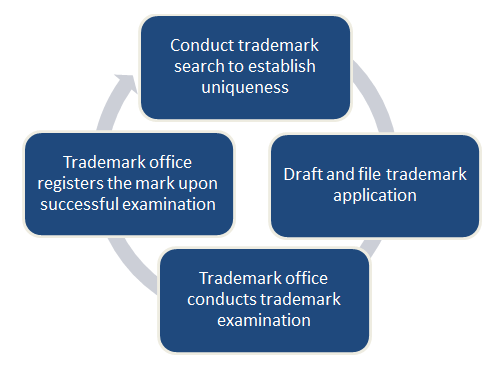Every company that plans to establish its business emphasizes creating a brand image for its customer. It is through the brand image that people connect, identify and differentiate their product or services from others. To build this identity, organizations must register their trademark as it helps them to enforce their legal rights upon violation. The following article discusses the process of trademark registration in India, its benefits, eligibility criteria, and more.
Also Read: How to Conduct Effective Trademark Searches in the U.S
Trademark Registration – Scope and Importance
A trademark can be a brand name, logo, word, phrase, symbol, design, and/or color combination. That defines the goods and services of an organization.
According to the Trademarks Act (TM Act), 1999, trademark registration in India is possible if it is graphically representable. Moreover, it is capable of distinguishing one’s goods or services from others. A trademark can be denied registration if: it deceives the public or causes confusion; consists of scandalous or obscene matter; hurt the religious susceptibilities of any class or section in India; or comprises marks prohibited from use under the Emblems and Names (Prevention of Improper Use) Act, 1950.
Any person claiming to be the trademark’s proprietor can file the application for trademark registration. This includes individuals, corporates, proprietary or partnership firms, start-ups, small enterprises, and trusts.
A registered trademark prevents other market players from riding on the back of a company’s business. Further, it prevents the violation of its exclusive rights to use, sell and modify products and services.
Also Read: Trademark Variation Searches: All You Need to Know
Trademark Registration Procedure in India
Trademark registration is a multi-step process that requires the support of trademark service providers. These providers remain well-equipped to help organizations at every step of their registration journey. They are experts in the field who fetch high-quality results while enabling businesses to focus on their core competencies. The graphic below encapsulates the process.

Step 1: Conduct Trademark Search
Before registering a trademark, organizations must ensure its uniqueness and that it’s not registered under the same class. To ensure this, trademark agents or attorneys conduct searches. One can perform the search both online and offline. However, one must use both methods to obtain better results.
Once the trademark agent identifies the mark as unique, organizations can move on to the second step. However, if the trademark is already registered, it needs to be changed. In some cases, the company may believe that the trademark is theirs because they use it before the other party. Here, the company starts using the ‘™’ symbol after filing the application, as the second step of the registration process.
Step 2: File Trademark Application
Based on the results of the search, the trademark agent drafts a trademark application. Then one files it with the Trademark Registry of India. The process, which is nowadays carried out online, is followed by receiving an official receipt for future references. The application must include details such as a brief description of services/goods linked with the trademark.
Step 3: Trademark Examination
Once you file the application, the examiner at the trademark office reviews it to rule out discrepancies. He/she will first assess whether the trademark has already undergone registration. If yes, an objection is raised. If not, the trademark will be accepted and published in the trademark journal.
It can take nearly 8 months to 2 years for the trademark office to decide whether to grant the registration. However, if objections are raised by the trademark office or a third party, it may take longer.
Step 4: Trademark Registration
The publication of a trademark is inclusive of the registration process so that those having concerns over its registration can raise an objection.
If there is no opposition from other businesses in the next four months from the date of publication, the trademark follows registration around six months later.
In case of an opposition, a fair hearing takes place and the final decision is by the Registrar. Once the application proceeds for trademark registration, the trademark office issues a registration certificate.
The validity of trademark registration in India is 10 years, after which trademark owners need to file a renewal application with the Registry to maintain registration. The trademark’s use is not mandatory for its maintenance or renewal. However, a registered trademark will become vulnerable to cancellation if not used continuously for five years after registration.
Once the trademark follows registration in India, it offers certain benefits to the owner.

Other Specifics About Trademark Registration
Apart from the procedure of trademark registration and its benefits, there are a few other aspects that applicants need to aware of to optimize the entire process. All the factors show their explanation below.
Also Read: How to Perform a TESS Trademark Search?
Documents Required for Trademark Registration
- Power of attorney
- Certified copy of the priority application, if priority is claimed
- Affidavit of use along with supporting documents, if the trademark’s prior use in India is claimed
Cost of Trademark Registration in India
In India, one receives a charge with a trademark registration fee on a per-application basis and classes per mark. In case the trademark receives opposition after acceptance and publication, one follows a separate procedure that involves additional charges depending on the facts of the case. The current official fee structure for trademark registration in India is Rs 4,500 for small firms, start-ups, and individuals, and Rs 9,000 for large-scale firms.
Also Read: Trademark Registrations: What Do You Need to Know?
Markings (Symbols)
As per India’s trademark law, it is not mandatory to use markings that indicate the use or registration of a trademark. However, the registered ® symbol still widely indicates a registered trademark, and the letters ‘TM’ indicates an unregistered trademark for which an application has been filed.
The use of these markings acts as a notice to the public regarding trademark rights. However, the registered ® symbol’s use for unregistered trademarks constitutes falsification of trademarks under the TM Act, which is a punishable offense with imprisonment extending from one to three years or a fine, or both.
Appealing Denied Application
Any decisions by the Registrar, including refusal orders, undergo reviewing process upon the filing of a review petition within one month of the Registrar’s order. Under the recently promulgated Tribunal Reforms (Rationalization and Conditions of Service) Ordinance 2021 (4 April 2021), one can appeal for the Registrar’s decision before the high courts within three months of his/her order.
Also Read: Hire a Trademark Attorney: What’s the Need?
Conclusion
A registered trademark acts as a catalyst for organizations to increase their value when business picks up pace. It is helpful for marketing strategies and strengthening brand recognition to attract more consumers. With more people realizing this fact, trademark filing has increased by 59.1% in India from the year 2014-15 to 2019-20. Thus, trademark registration has become vital for businesses to remain competitive.
TMReady’s trademark filing and prosecution services enable businesses to choose the right trademark and file a strong registration application for it. Our team of trademark professionals is adept at assisting organizations with the procedure and other incidental matters related to it.
– Yogesh Kumar (Trademark) and the Editorial Team
